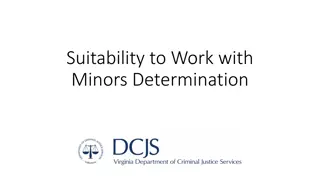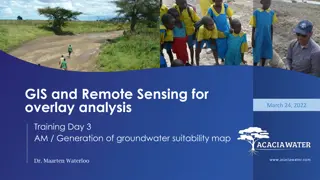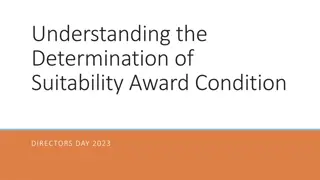Suitability of IEEE 802.11ah for LPWAN Applications Analysis
This document analyzes the suitability of IEEE 802.11ah for Low Power Wide Area Network (LPWAN) applications. It examines the features of IEEE 802.11ah, such as OFDM-based FEC and its performance in fulfilling LP-WAN use-cases. The document also discusses channel models, interference resistance, and the impact of active interfering users on IEEE 802.11ah. Overall, it provides insights into the applicability of IEEE 802.11ah in LPWAN scenarios.
Download Presentation

Please find below an Image/Link to download the presentation.
The content on the website is provided AS IS for your information and personal use only. It may not be sold, licensed, or shared on other websites without obtaining consent from the author. Download presentation by click this link. If you encounter any issues during the download, it is possible that the publisher has removed the file from their server.
E N D
Presentation Transcript
March 2017 doc.: IEEE 802. 15-17-0162-00-lpwa Project: IEEE P802.15 Working Group for Wireless Personal Area Networks (WPANs) Submission Title: [Suitability of IEEE 802.11ah for LPWAN Applications] Date Submitted: [12 March, 2017] Source: [Joerg ROBERT] Company [Friedrich-Alexander University Erlangen-Nuernberg] Address [Am Wolfsmantel 33, 91058 Erlangen, Germany] Voice:[+49 9131 8525373], FAX: [+49 9131 8525102], E-Mail:[joerg.robert@fau.de] Re: [] Abstract: [This documents analyzes the suitability of IEEE 802.11ah for LPWAN applications] Purpose: [Presentation within IG LPWA] Notice: This document has been prepared to assist the IEEE P802.15. It is offered as a basis for discussion and is not binding on the contributing individual(s) or organization(s). The material in this document is subject to change in form and content after further study. The contributor(s) reserve(s) the right to add, amend or withdraw material contained herein. Release: The contributor acknowledges and accepts that this contribution becomes the property of IEEE and may be made publicly available by P802.15. Submission Slide 1 Joerg ROBERT, FAU Erlangen-Nuernberg
March 2017 doc.: IEEE 802. 15-17-0162-00-lpwa Suitability of IEEE 802.11ah for LPWAN Applications Joerg Robert FAU Erlangen-Nuernberg Submission Slide 2 Joerg Robert, FAU Erlangen-Nuernberg
March 2017 doc.: IEEE 802. 15-17-0162-00-lpwa Motivation IEEE 802.11ah is an amendment operated in sub- GHz bands with focus on IoT applications OFDM based Powerful FEC, sophisticated MAC with single-hop Minimum bandwidth of 1MHz The performance for IEEE 802.11ah given in 802.11- 11/1137r15 Is 802.11ah able to fulfill certain LP-WAN use-cases defined in 16/770r3? Submission Slide 3 Joerg Robert, FAU Erlangen-Nuernberg
March 2017 doc.: IEEE 802. 15-17-0162-00-lpwa Channel Model Indoor Outdoor Rural Outdoor Urban OFDM is robust wrt. multi-path propagation The high bandwidth of at least 1 MHz offers significant diversity gain Submission Slide 4 Joerg Robert, FAU Erlangen-Nuernberg
March 2017 doc.: IEEE 802. 15-17-0162-00-lpwa Interference Model None Low Medium Dense The high bandwidth and the powerful forward error correction result in a good interference resistance However, in case of many interferes the high bandwidth will collect high interference levels Submission Slide 5 Joerg Robert, FAU Erlangen-Nuernberg
March 2017 doc.: IEEE 802. 15-17-0162-00-lpwa Active Interfering Users Low Medium High Very High The high bandwidth generally limits the number of parallel users The use of sophisticated multi-antenna schemes increases the performance in case of many users Submission Slide 6 Joerg Robert, FAU Erlangen-Nuernberg
March 2017 doc.: IEEE 802. 15-17-0162-00-lpwa Communication Mode Uplink Downlink Uplink / Broadcast Downlink 802.11ah has been designed for up- and downlink communication Submission Slide 7 Joerg Robert, FAU Erlangen-Nuernberg
March 2017 doc.: IEEE 802. 15-17-0162-00-lpwa Data Period Occasionally, less than 1/day Occasionally 1/day Occasionally 1/hour Occasionally, more than 1/hour Periodically 1/day Periodically 1/hour Periodically, more than 1/hour The use of DSSS is independent of the data period Submission Slide 8 Joerg Robert, FAU Erlangen-Nuernberg
March 2017 doc.: IEEE 802. 15-17-0162-00-lpwa Data Length <= 16 bytes <= 64 bytes <= 256 bytes > 256 bytes The use of DSSS is independent of the data length Submission Slide 9 Joerg Robert, FAU Erlangen-Nuernberg
March 2017 doc.: IEEE 802. 15-17-0162-00-lpwa Availability Best effort ( > 90%) Medium ( > 99% ) High ( > 99.9% ) Packet retransmissions and powerful MAC mechanisms ensure a high availability Submission Slide 10 Joerg Robert, FAU Erlangen-Nuernberg
March 2017 doc.: IEEE 802. 15-17-0162-00-lpwa Latency < 0.25s < 1s < 10s < 1min < 10min < 60 min < 1day The high data rates offer a high latency Short latencies may not be met if power saving techniques are used Submission Slide 11 Joerg Robert, FAU Erlangen-Nuernberg
March 2017 doc.: IEEE 802. 15-17-0162-00-lpwa LP-WAN Localization < 10m < 100m Not required The high bandwidth of the signal may allow for good and precise localization if multiple access points are used Submission Slide 12 Joerg Robert, FAU Erlangen-Nuernberg
March 2017 doc.: IEEE 802. 15-17-0162-00-lpwa Typical Power Supply CR 2025 2xAA Energy harvesting External The use of OFDM may result in inefficient transmission in case of higher transmit powers Submission Slide 13 Joerg Robert, FAU Erlangen-Nuernberg
March 2017 doc.: IEEE 802. 15-17-0162-00-lpwa Frequency Regulation NA ETSI FCC ETSI/FCC Current status within ETSI not completely clear, may be used with 25mW EIRP and low duty cycle in bands to are also used by RFID applications with high power Submission Slide 14 Joerg Robert, FAU Erlangen-Nuernberg
March 2017 doc.: IEEE 802. 15-17-0162-00-lpwa Minimum Sensitivity Requirements Minimum Sensitivity (1MHz PPDU) (dBm) Minimum Sensitivity (2MHz PPDU) (dBm) Minimum Sensitivity (4MHz PPDU) (dBm) Minimum Sensitivity (8MHz PPDU) (dBm) Minimum Sensitivity (16MHz PPDU) (dBm) Modulation Rate (R) 1/2 & 2x repetition BPSK -98 n.a. n.a. n.a. n.a. BPSK 1/2 -95 -92 -89 -86 -83 Required input level of -98dBm for most robust mode QPSK 1/2 -92 -89 -86 -83 -80 QPSK 3/4 -90 -87 -84 -81 -78 16-QAM 1/2 -87 -84 -81 -78 -75 16-QAM 3/4 -83 -80 -77 -74 -71 64-QAM 2/3 -79 -76 -73 -70 -67 64-QAM 3/4 -78 -75 -72 -69 -66 64-QAM 5/6 -77 -74 -71 -68 -65 Source: 802.11-11/1137r15 (PER of 10% for a PSDU length of 256 octets) 256-QAM 3/4 -72 -69 -66 -63 -60 256-QAM 5/6 -70 -67 -64 -61 -58 Submission Slide 15 Joerg Robert, FAU Erlangen-Nuernberg
March 2017 doc.: IEEE 802. 15-17-0162-00-lpwa Maximum Acceptable Path Loss Outdoor Model as defined in 17/36r1 Base-Station antenna height = 30m Mobile-Station antenna height = 2m Transmit power 10dBm (0 dBi TX antenna gain) 10dBi RX antenna gain Max pathloss 118dB Small cell size Submission Slide 16 Joerg Robert, FAU Erlangen-Nuernberg
March 2017 doc.: IEEE 802. 15-17-0162-00-lpwa Cell Radius < 1 km < 5 km < 10 km < 50 km > 50 km The high payload bit-rates in (reflected in the required minimum input power of -98dBm) do not allow for long-range transmission In case of exposed antennas the system will be interfered by other users due to its high bandwidth Submission Slide 17 Joerg Robert, FAU Erlangen-Nuernberg
March 2017 doc.: IEEE 802. 15-17-0162-00-lpwa Data Security Layer-2 Layer-3 End-to-End Secure Authentication IEEE 802.11ah implements already security Additional security can be added on higher layers Submission Slide 18 Joerg Robert, FAU Erlangen-Nuernberg
March 2017 doc.: IEEE 802. 15-17-0162-00-lpwa Node Velocity 3 km/h 30 km/h 120 km/h OFDM parameters may allow also high speed operation in case of a sophisticated receiver Submission Slide 19 Joerg Robert, FAU Erlangen-Nuernberg
March 2017 doc.: IEEE 802. 15-17-0162-00-lpwa Results of the Suitability Evaluation IEEE 802.11ah does not support: Scenarios with strong interference ETSI regulation Medium/Large cell radiuses Results are evaluate using use-cases in 16/770r3 A use-case is not supported if at least one criteria is not fulfilled Submission Slide 20 Joerg Robert, FAU Erlangen-Nuernberg
March 2017 doc.: IEEE 802. 15-17-0162-00-lpwa Results of the Suitability Evaluation Access Control Public Lighting Alarms and Security Smart Grid - Fault Monitoring Asset Tracking Smart Grid - Load Control Assisted Living Smart Metering Cattle Monitoring Smart Parking Field Monitoring Smoke Detectors Global Tracking Structural Health Monitoring Industrial Plant Condition Monitoring Vending Machines - general Industrial Production Monitoring Vending Machines - privacy Light Switch Waste Management Pet Tracking Water Pipe Leakage Monitoring Pipeline Monitoring - Terrestrial Submission Slide 21 Joerg Robert, FAU Erlangen-Nuernberg
March 2017 doc.: IEEE 802. 15-17-0162-00-lpwa Thank You! Questions or Comments? Submission Slide 22 Joerg Robert, FAU Erlangen-Nuernberg























